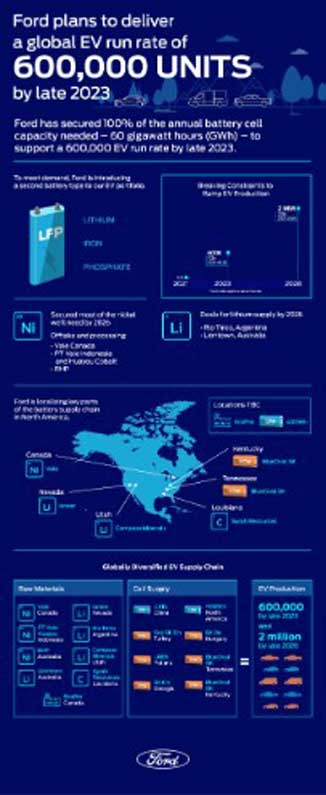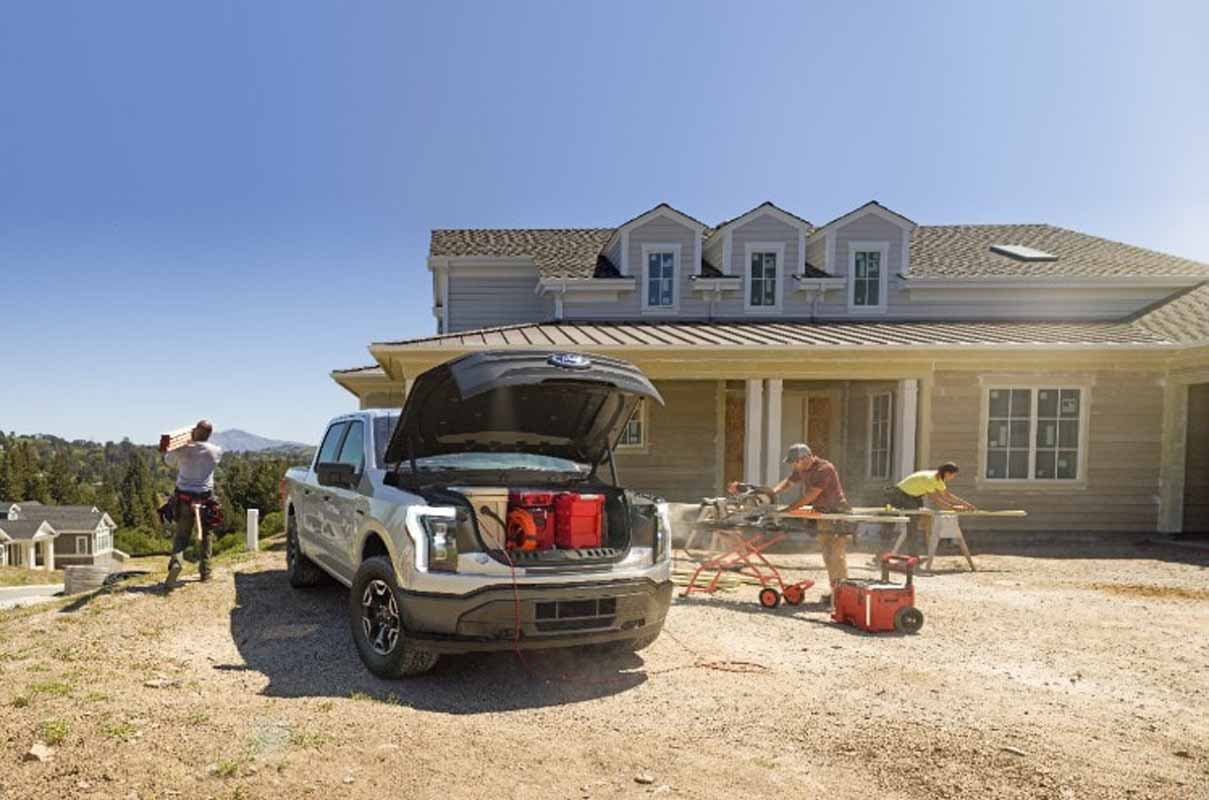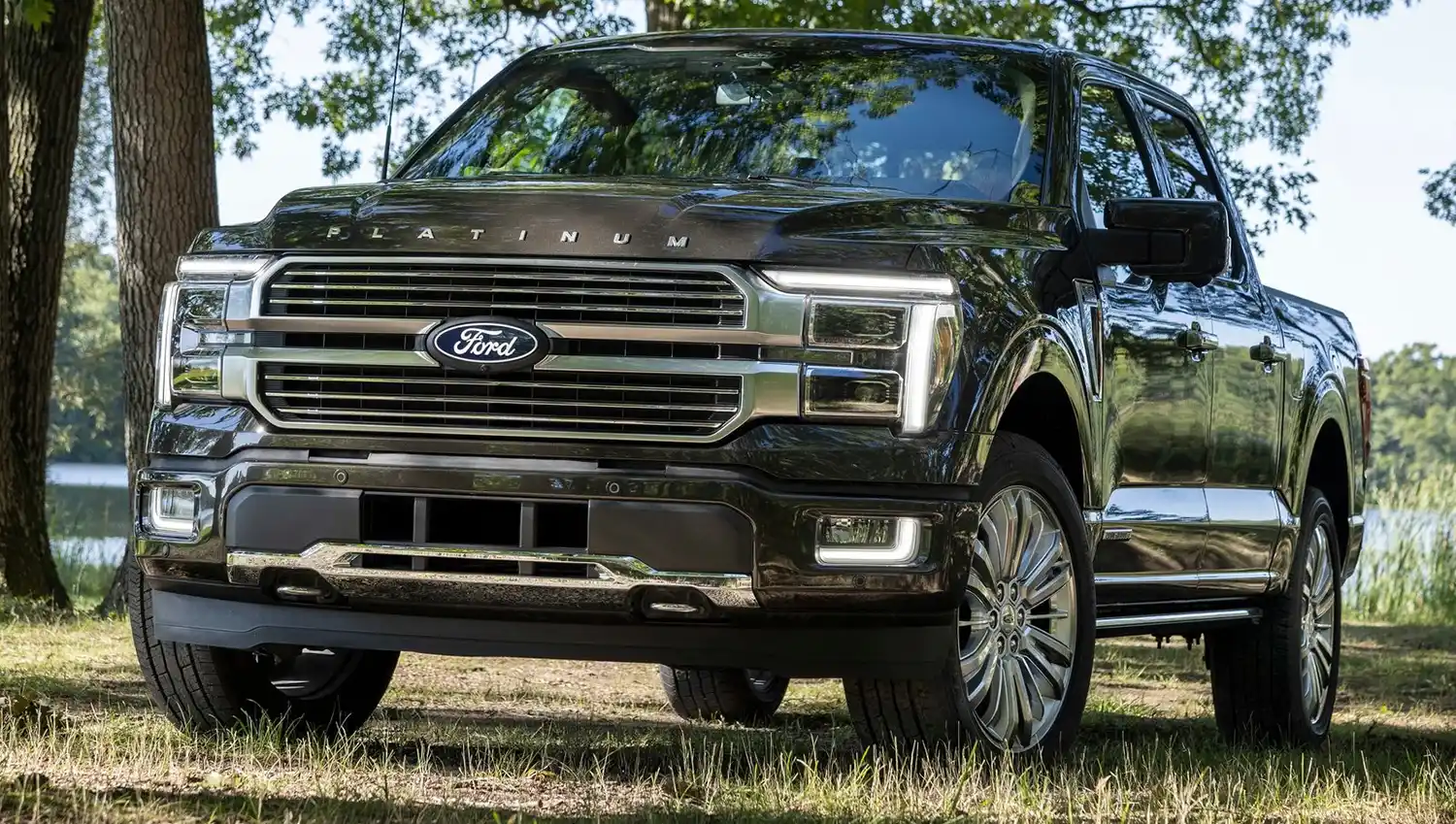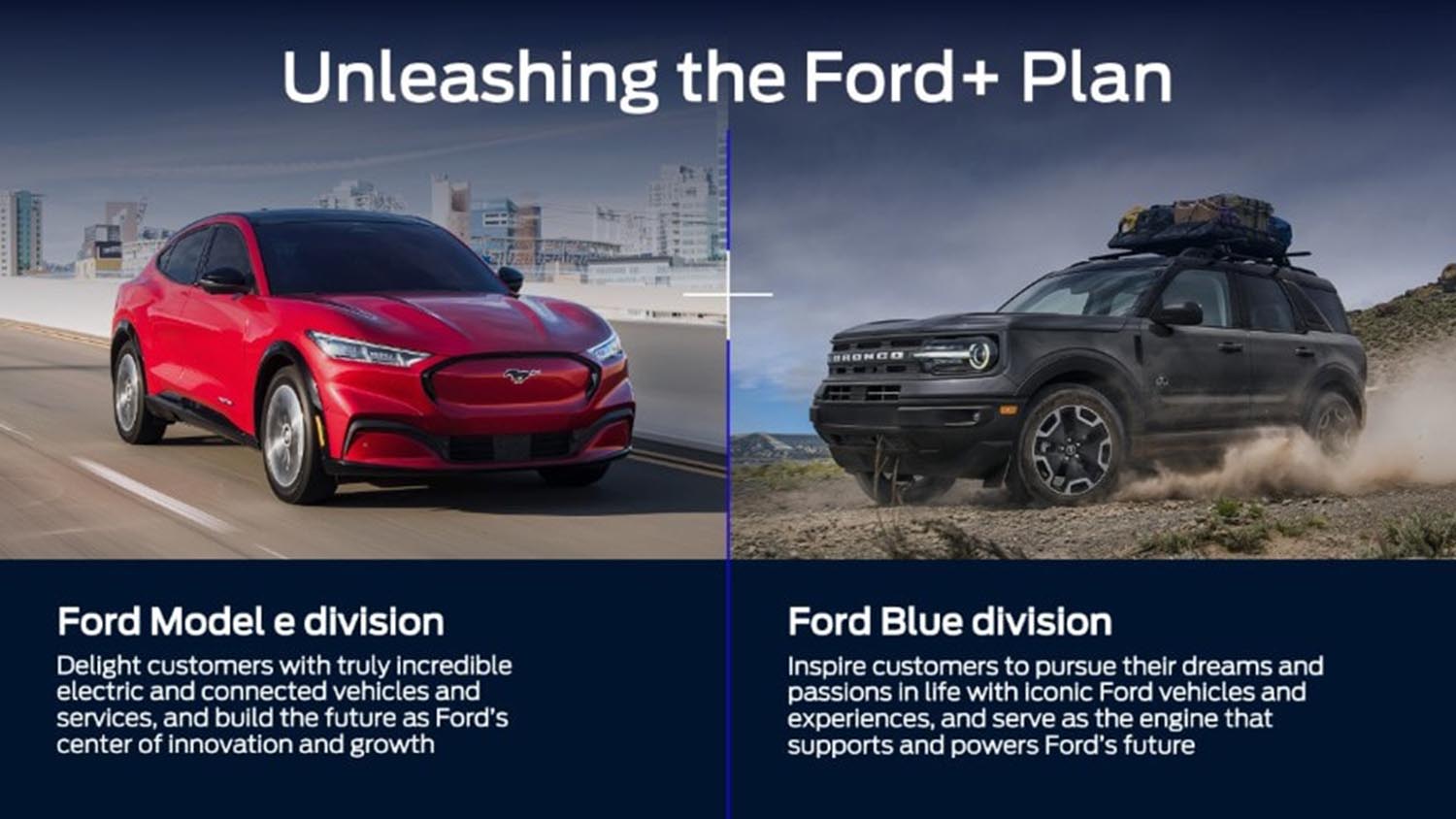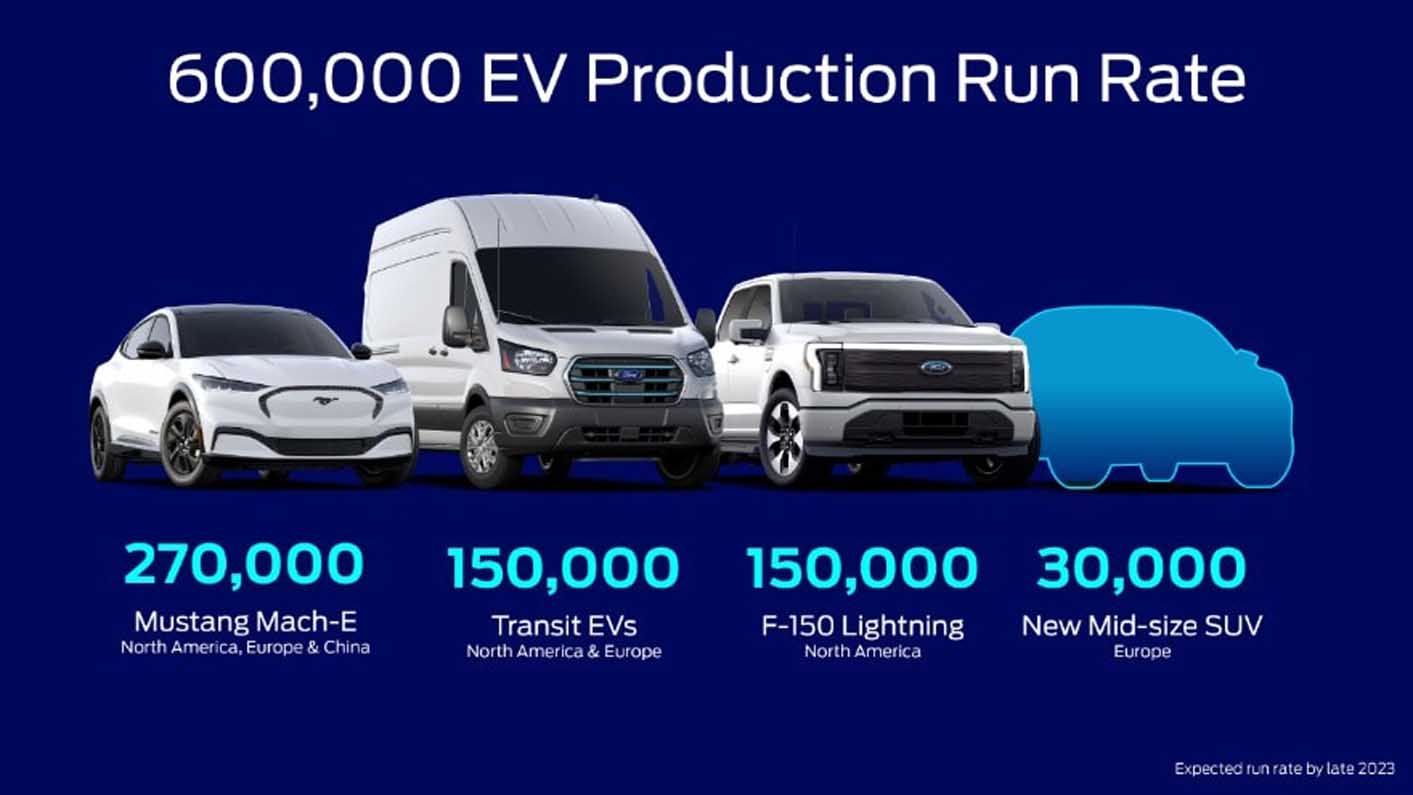
Building on strong demand for its new EVs, Ford today announced a series of initiatives for sourcing battery capacity and raw materials that light a clear path to reach its targeted annual run rate of 600,000 electric vehicles by late 2023 and more than 2 million by the end of 2026.
The company detailed its global vehicle portfolio plans supporting these production goals as part of its Ford+ plan. Ford expects a compound annual growth rate for EVs to exceed 90% through 2026, more than double forecasted global industry growth.
“Ford’s new electric vehicle lineup has generated huge enthusiasm and demand, and now we are putting the industrial system in place to scale quickly,” said Jim Farley, Ford’s president and CEO and president of Ford Model e. “Our Model e team has moved with speed, focus and creativity to secure the battery capacity and raw materials we need to deliver breakthrough EVs for millions of customers.”
Ford plans to invest over $50 billion in EVs through 2026, targeting total company adjusted EBIT margins of 10% and 8% EBIT margins for EVs by 2026.
As Ford creates a new EV supply chain that upholds its commitments to sustainability and human rights, the company continues to plan for more than half its global production to be EVs by 2030 and achieving carbon neutrality globally no later than 2050.
Driving to the 600,000 EV run rate by late 2023
Ford plans to reach a 600,000 global EV run rate by late 2023 with the following EVs:
- 270,000 Mustang Mach-Es for North America, Europe and China
- 150,000 F-150 Lightnings for North America
- 150,000 Transit EVs for North America and Europe
- 30,000 units of an all-new SUV for Europe, whose run rate will significantly ramp in 2024
Ford is adding lithium iron phosphate (LFP) cell chemistry to its portfolio, alongside its existing nickel cobalt manganese (NCM) chemistry. This creates even more capacity for high-demand products and provides customers many years of operation with minimal range loss. It also reduces the reliance on scarce critical minerals such as nickel and, at current costs, brings a 10 to 15% bill of material savings for Ford versus NCM batteries.
The company confirmed it has secured 100% of the annual battery cell capacity needed – 60 gigawatt hours (GWh) – to support this 600,000 EV run rate by working with leading battery companies around the globe.
Ford announced that Contemporary Amperex Technology Co., Ltd. (CATL) will provide full LFP battery packs for Mustang Mach-E models for North America starting next year as well as F-150 Lightnings in early 2024. Ford’s EV architecture flexibility allows efficient incorporation of CATL’s prismatic LFP cell-to-pack technology, delivering incremental capacity quickly to scale and meet customer demand.
Ford also is leveraging its long-standing connection with LG Energy Solution (LGES) and its strategic relationship with SK On to meet its battery capacity target for late 2023.
Long-time supplier LGES has scaled quickly and doubled its capacity at its Wroclaw, Poland, facility to support incremental NCM cell production for Mustang Mach-E and E-Transit models.
Plus, SK On has installed capacity to support the scaling of Ford’s high-volume F-150 Lightning and E-Transits through late 2023 – scaling NCM cell production beyond earlier-planned levels from its Atlanta facility and providing new battery cell capacity from its Hungary operation.
Driving to more than 2 million EVs by late 2026
Ford is building on agreements tied to its 600,000 run rate milestone and is taking them even further. The company now has sourced approximately 70% of the battery cell capacity it needs to support an annual global run rate of more than 2 million EVs by late 2026.
Ford and CATL – the world’s largest battery producer – have signed a separate non-binding MOU to explore a cooperation for supplying batteries in Ford’s markets across China, Europe and North America.
Ford also announced it plans to localize and use 40 GWh of LFP capacity in North America starting in 2026.
The company intends to use this additional capacity to complement three previously announced battery plants in Kentucky and Tennessee that are part of the BlueOval SK joint venture between Ford and SK On, which was officially formed last week. Ford has signed an additional MOU with SK On as well as Koç Holdings to create a joint venture in Turkey for expanded battery capacity there.
To support its joint ventures, Ford is direct-sourcing battery cell raw materials as well.
“Our team has been actively engaged with partners in the United States and around the world,” said Lisa Drake, Ford Model e vice president, EV Industrialization. “We will move fast in the key markets and regions where critical supplies are available, meeting with government officials, mining companies and processors and signing MOUs and agreements that reflect Ford’s ESG expectations and underpin Ford’s plan to bring EVs to millions.”
Today, the company announced it is working with major mining collaborators and has sourced most of the nickel needed through 2026 and beyond. Ford has signed non-binding MOUs with:
- Vale Canada Ltd.: To explore potential opportunities across the EV value chain.
- PT Vale Indonesia and Huayou Cobalt: For exploring a three-way nickel processing project and, separately, an off-take agreement with Huayou that collectively will provide Ford with rights to the equivalent of 84 kilotons per annum (ktpa) of nickel.
- BHP: For nickel supply from BHP’s Nickel West operations in Australia. The targeted multi-year agreement could start as early as 2025 and may involve additional commodities over time.
Ford also has locked several key lithium contracts. Beyond the recently announced key asset in Western Australia secured through Liontown Resources, Ford also has signed a non-binding MOU with Rio Tinto, exploring a significant lithium off-take agreement from its Rincon project in Argentina. This is part of a multi-metal MOU that leverages the scale of Ford’s aluminum business and includes a potential opportunity on copper.
Ford also continues working to localize processing of key battery materials in North America. To that end, the company is announcing:
- EcoPro BM and SK On: Have signed a non-binding Letter of Intent with Ford to establish a cathode production facility in North America.
- ioneer: Has signed a binding off-take agreement with Ford for lithium carbonate from ioneer’s Rhyolite Ridge project in Nevada to support EV production beyond 2025.
- Compass Minerals: Has signed a non-binding MOU for lithium hydroxide and lithium carbonate from its Utah operations on the Great Salt Lake.
- Syrah Resources and SK On: Have signed a non-binding MOU to secure off-take for natural graphite from its processing site in Vidalia, Louisiana.
“It’s a very competitive landscape. These collaborators see value in the strong demand we have created with exceptional products like Mustang Mach-E and F-150 Lightning and the stability we can bring to these relationships,” Drake said. “We are excited to work with them – and others we haven’t yet announced – to build this new global supply chain for Ford.”
EV Demand
As Ford reinvents its new EV supply chain, consumer praise rolls in for its first-generation EVs already in-market while demand signals among potential EV buyers continue strengthening.
For the first time, the majority of consumers who intend to buy a car in the next two years say they will choose an EV or hybrid vehicle – up 11% from last year and 22% from 2020, according to research published by EY. Most of that increase is for full EVs.
Among commercial owners who don’t already deploy EVs, 60% of U.S. fleet managers said in a Ford Pro survey they plan to add EVs to their operations within two years.
Market reaction to F-150 Lightning and Mustang Mach-E is strong, bringing all-new customers to Ford. Mustang Mach-E shares the top spot in its segment for in-market vehicle shoppers’ favorable opinion, according to a Q1 Ford study, while F-150 Lightning’s favorable opinion was second only to the F-150 powered by an internal combustion engine.
To further stimulate demand, Ford is working to make EVs accessible to millions, addressing barriers to entry such as charging, cost and improving the EV customer purchase experience.
“This is our opportunity to win a whole new group of customers, building their loyalty and advocacy as we grow our market share,” said Marin Gjaja, Ford Model e chief customer officer. “We’re developing the digital and physical services and experiences those new customers expect when they purchase a product that to them is a new technology purchase. Our aim is to combine the convenience of digital shopping with Ford’s expertise, scale and the physical presence of our dealers to create the best possible experience for tomorrow’s EV owners.”
